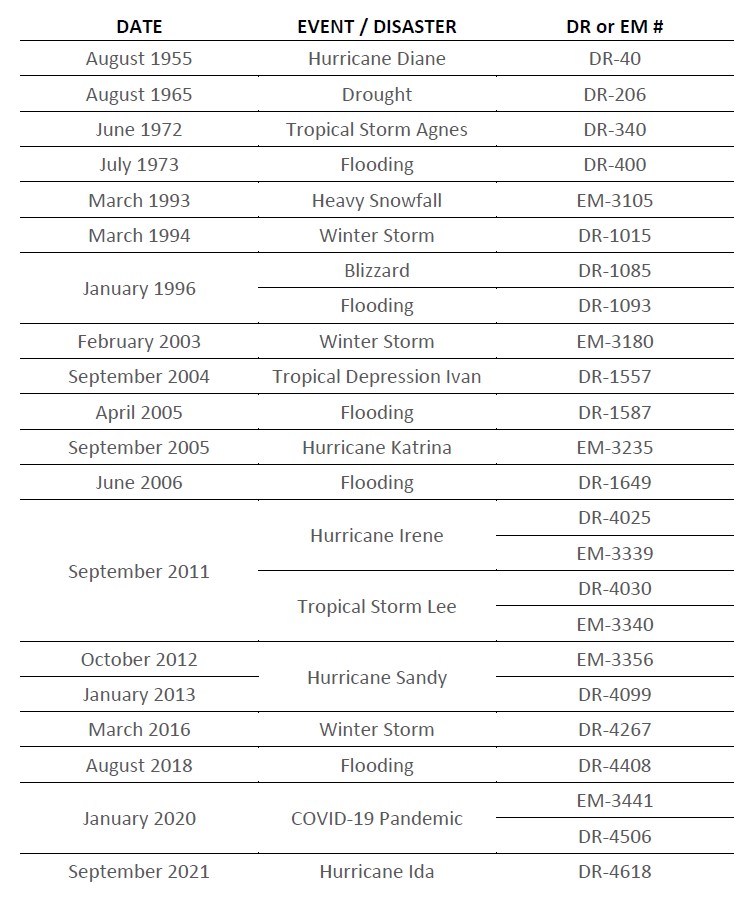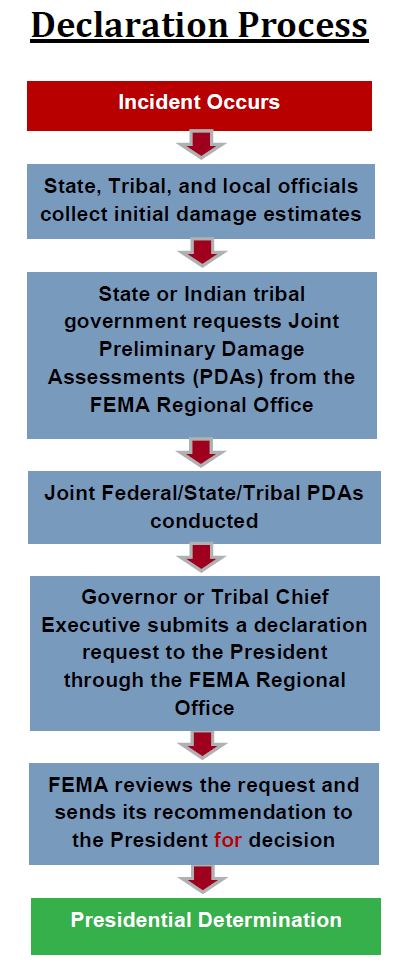Disaster Recovery Information, Forms & Resources
Active Disaster Declarations
(Click on buttons to learn more)
How a Disaster Gets Declared
The information below provides procedural information regarding the Stafford Act declaration process and is intended for emergency managers, elected officials, media, and stakeholders interested in the formal declaration process. All emergency and major disaster declarations are made solely at the discretion of the President of the United States.
The Robert T. Stafford Disaster Relief and Emergency Assistance Act, 42 U.S.C. §§ 5121-5207 (the Stafford Act) §401 states in part that: “All requests for a declaration by the President that a major disaster exists shall be made by the Governor of the affected State.” A State also includes the District of Columbia, Puerto Rico, the Virgin Islands, Guam, American Samoa, and the Commonwealth of the Northern Mariana Islands. The Republic of Marshall Islands and the Federated States of Micronesia are also eligible to request a declaration and receive assistance through the Compacts of Free Association.
As a result of the Sandy Recovery Improvement Act, federally recognized Indian tribal governments now have the option of pursuing a declaration directly from the President. FEMA has developed Tribal Declarations Pilot Guidance, which provides more detailed and specific guidance for Tribal requests.
FEMA has codified the declaration process at 44 C.F.R. Part §206, Subpart B.
Presidential Disaster & Emergency Declaration History
The information below provides procedural information regarding the Stafford Act declaration process and is intended for emergency managers, elected officials, media, and stakeholders interested in the formal declaration process. All emergency and major disaster declarations are made solely at the discretion of the President of the United States.
The Robert T. Stafford Disaster Relief and Emergency Assistance Act, 42 U.S.C. §§ 5121-5207 (the Stafford Act) §401 states in part that: “All requests for a declaration by the President that a major disaster exists shall be made by the Governor of the affected State.” A State also includes the District of Columbia, Puerto Rico, the Virgin Islands, Guam, American Samoa, and the Commonwealth of the Northern Mariana Islands. The Republic of Marshall Islands and the Federated States of Micronesia are also eligible to request a declaration and receive assistance through the Compacts of Free Association.
As a result of the Sandy Recovery Improvement Act, federally recognized Indian tribal governments now have the option of pursuing a declaration directly from the President. FEMA has developed Tribal Declarations Pilot Guidance, which provides more detailed and specific guidance for Tribal requests.
FEMA has codified the declaration process at 44 C.F.R. Part §206, Subpart B.


How to Conduct a Preliminary Damage Assessment
- Local Damage Assessment – The process starts at the local level where damage details are initially collected, shared, and validated by state, tribal and territorial authorities.
- State or Tribal Verification – The state, tribe or territory generally has thirty (30) days from the start of the incident to determine whether or not federal assistance in the form of FEMA Individual Assistance, Public Assistance or other federal programs may be necessary.
- Joint PDA – If the incident is of a severity and magnitude that resources needed to recover are expected to exceed local and state or tribal government capability, the director of the state or tribal emergency management agency may request a Joint PDA from the appropriate FEMA Regional Administrator to validate damage and evaluate impact. This request should include any counties or tribal lands to be assessed and will begin discussion on the general timeline for the Joint PDA. Together, the team will conduct a thorough assessment of the impacted area to determine: the extent of the disaster, its impact on individuals and public facilities, and the types of federal assistance that may be needed.
- FEMA Regional Office – Once a request for a Joint PDA is made, a summary of the information verified by the state or tribal emergency management should be provided to the FEMA Regional Recovery Division. FEMA programmatic representatives should coordinate with state or tribal emergency management agencies to discuss the information submitted, determine team requirements, establish a PDA briefing time and location, and develop an overall PDA coordinating plan.
- FEMA Headquarters – FEMA Headquarters reviews the request to ensure it’s consistent with declaration policy and process. The FEMA Administrator will then review the request, informs and makes recommendations provided by the Regional Administrator.
- President – The President of the United States makes the disaster declaration decision.
* Not every incident will result in the need for a PDA or federal assistance. Extensions may be granted upon request.
Preliminary Damage Assessment (PDA) Forms / Information
|
Public Assistance (PA) Resources |
Individual Assistance (IA) Resources |
Public Assistance Forms & Resources
When gearing up to apply for Public Assistance, here are the necessary program forms and resources to help you with the process.
Important info & forms, such as:
-
- Disaster Assistance Program (DAP) Forms
- FEMA Approved Equipment Rates
- Debris Management
- Donated Resources
- Private Nonprofits and
- Procurement
Can be found at PEMA PA Forms page
If you have questions or need assistance please contact:
Mr. Thomas E. Guth, Jr.
Hazard Mitigation / Disaster Recovery Manager